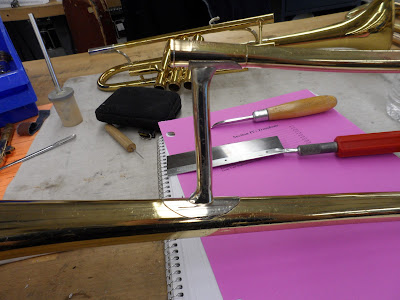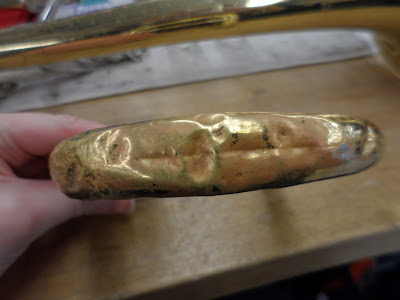Aw, that's a huge gap. Something is really off.
Time to saw my trombone into pieces! HA!
Oh no, I sawed the brace in half! Yeah, now I can adjust the brace better to the gooseneck of the trombone.
Cut this tube Greg said, it's brass Greg said. So I cut it, and buffed the piece. Turns out it's nickel silver. If you've ever stood buffing what you thought was brass thinking "I'm going crazy, this is brass, it's just really shiny", then you should know what I mean.
The large "ferrule" I made out of the tube, to cover the cut I made.
Doesn't that look nice? The gooseneck is not on the horn in this picture, but it's right there on my bench.
Wiring that so it doesn't move when I solder it together.
Oh, that looks pretty nice. It just needs some (a lot) of buffing.
Alright, so I put the rest of the trombone together, and managed to solder this stuck. Luckily I was able to heat it up quickly and gently pull it loose. Greg said this wouldn't happen if I put grease on it, which I did, but maybe I didn't put enough or some flux got in there.
Oh... That's not supposed to happen. There is a gap between the parts, this is the main tuning slide and it should go all the way in.
Whoo, fixed that. Now it goes all the way in.
Greg took a french horn apart for us. The rotor oil had some really... interesting reaction to the slide grease someone used. Luckily my friend Whitney got a recording of Greg's reaction to this reaction. He thought this goo looked really gross.
Mm. Green slime.
It's all over the place. Yuck! I should probably mention that I found the same goo in my horn. Yay.
French horn stringing. Isn't it pretty?
Those are the bearing plates of a french horn. They're right under the caps.
The long bar on the left is a bridge that the spatulas (keys/buttons) are mounted on. The screw that holds it down (not seen in this picture) was stuck on my horn, so that took a while to get unstuck. Hooray for penetrating oil!
Yuck. Slimy rotors from my horn. This needs to be cleaned.
Horn stringing. This string makes the rotor move, so that when the player presses the spatula (key/button) the rotor rotates.
Oh, what a nice dent in my methods horn.
And the brace that caused the dent is missing too.
Honing a tool bit. This means rubbing a tool bit on a honing block until it's perfect.
And done honing.
































































